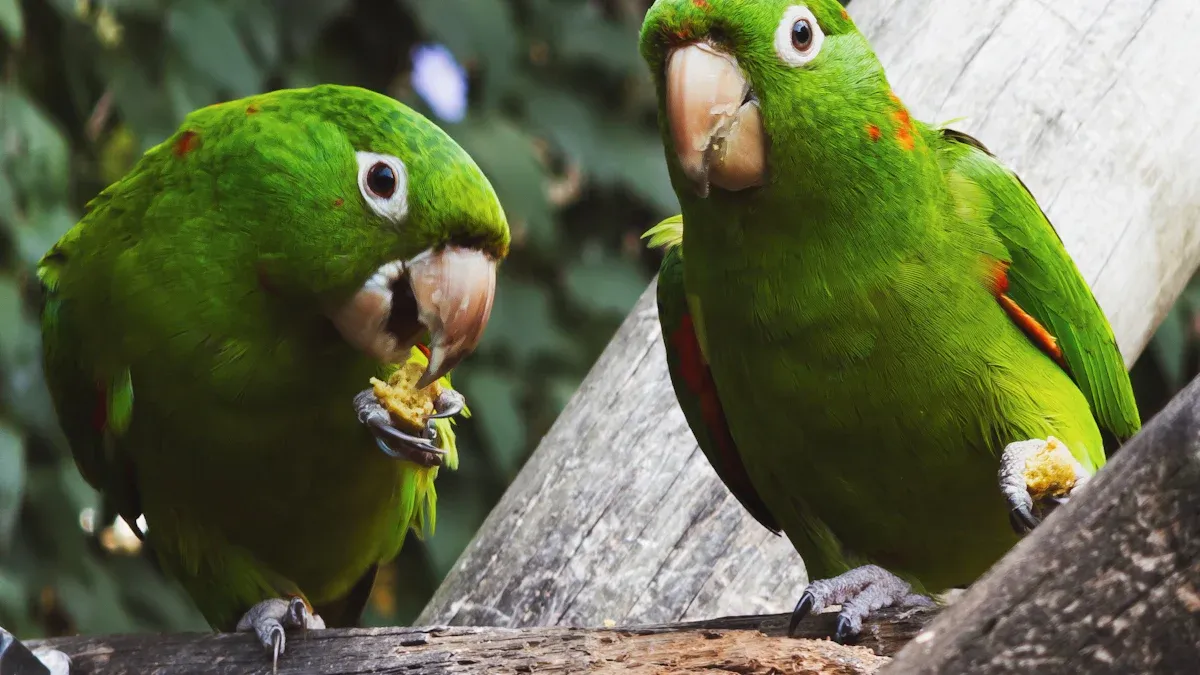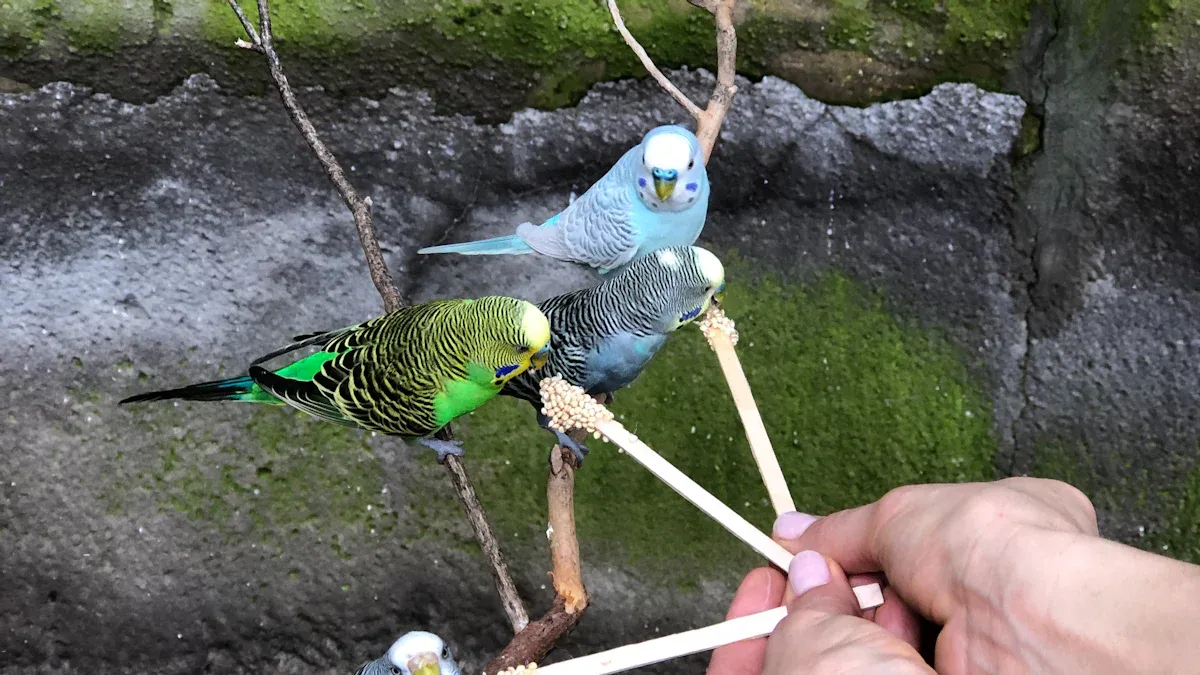
Mealworms for parrots serve as a vital source of nutrition, particularly for active birds. These insects provide high levels of protein and essential nutrients. Active parrots require a diet rich in these elements to maintain their energy and overall health.
المداخل الرئيسية
- Mealworms are a rich source of protein, containing about 53% protein per 100 grams, making them ideal for active parrots needing energy.
- Incorporating mealworms into a parrot’s diet supports brain function, skin health, and feather quality due to their essential fatty acids.
- Feed mealworms in moderation, ideally 2-4 mealworms two to three times a week, to ensure a balanced diet without overfeeding.
الفوائد الغذائية لديدان الوجبة للببغاوات
Mealworms for parrots offer numerous nutritional benefits that support their active lifestyles. These insects are packed with essential nutrients that contribute to a parrot’s overall health and vitality.
High Protein Content
One of the most significant advantages of mealworms is their high protein content. Dried mealworms contain approximately 53% protein per 100 grams, making them an excellent source of this vital nutrient. In comparison, other common parrot foods, such as black oil sunflower seeds and crickets, provide lower protein levels, as shown in the table below:
| Food Source | Protein Content (per 100g) |
|---|---|
| Dried Mealworms | 53% |
| Live Mealworms | 20% |
| Black Oil Sunflower Seeds | 15% |
| Defatted Mealworm Powder | 64% |
| Whey | 34g (ΣEAA) |
| الكريكيتس | 39g (ΣEAA) |
| Soy | 20g (ΣEAA) |
| Pea | 24g (ΣEAA) |
Mealworms provide all essential amino acids needed for muscle growth, tissue repair, and feather health. They contain the same ten essential amino acids required by all vertebrates, offering complete protein. This makes mealworms a valuable addition to a parrot’s diet, especially for those that are active and require more protein to support their energy levels.
Essential Fatty Acids
In addition to protein, mealworms are rich in essential fatty acids, particularly omega-3 and omega-6. These fatty acids play a crucial role in maintaining brain function, skin health, and feather quality. Including mealworms in a parrot’s diet can enhance cognitive abilities and promote vibrant plumage.
- Mealworms support brain function and cognitive development.
- They help maintain healthy skin and feathers.
- The omega-6 to omega-3 ratio in mealworms is more favorable compared to many other diets, promoting overall health.
Vitamins and Minerals
Mealworms also provide a range of vitamins and minerals that are beneficial for parrots. While they contain small amounts of vitamins A, B, and E, they may not be sufficient if mealworms are the sole food source. Parrots require a balanced diet that includes various food types to meet their vitamin and mineral needs.
| نوع المغذيات | Mealworms Provide | Deficiencies from Exclusive Diet |
|---|---|---|
| Protein | Yes | لا |
| Healthy Fats | Yes | لا |
| Vitamins A, B, E | Small amounts | Yes (if not combined with other sources) |
| Iron, Zinc, Copper | Yes | Yes (if not combined with other sources) |
| Complete Amino Acids | Yes | Yes (if not combined with other sources) |
Mealworms vs. Other Food Options
When considering the best diet for parrots, it is essential to compare mealworms with other food options. Each type of food offers unique benefits and drawbacks. Understanding these differences helps parrot owners make informed decisions.
Seeds and Pellets
Seeds and pellets are common staples in many parrot diets. However, they differ significantly from mealworms in terms of nutritional value.
- البذور often contain high fat levels but lower protein content. For example, sunflower seeds provide about 15% protein but can be high in fat.
- Pellets are formulated to provide balanced nutrition. They often contain a mix of grains, seeds, and vitamins. However, many pellets lack the high protein levels found in mealworms.
The table below highlights the nutritional differences between mealworms and soybeans, a common seed alternative:
| Nutrient | الديدان | Soybeans |
|---|---|---|
| Protein | 53% | 50% |
| Fat | 28% (mostly unsaturated) | High |
| Fiber | 6% | N/A |
| الكربوهيدرات | N/A | Present |
| Essential Amino Acids | High in Lysine and Leucine | High in Methionine and Tryptophan |
| المغذيات الدقيقة | Magnesium, Zinc, Iron, etc. | Molybdenum, Manganese |
| Vitamins | B-vitamins, some Vitamin C | N/A |
Mealworms provide a more concentrated source of protein and essential amino acids compared to seeds and pellets. This makes them a valuable addition to the diets of active parrots.
Fresh Fruits and Vegetables
Fresh fruits and vegetables are vital for a balanced parrot diet. They provide essential vitamins, minerals, and hydration. However, they should complement the protein-rich foods like mealworms.
- النباتات should outnumber fruits in a parrot’s diet by about 10:1. This ratio ensures that parrots receive adequate nutrients without excessive sugar from fruits.
- Certain species, such as Caiques, Eclectus, and Lories, may require more fruit in their diets.
Incorporating mealworms alongside fresh produce can enhance a parrot’s overall nutrition. The combination of protein from mealworms and vitamins from fruits and vegetables creates a well-rounded diet.
Other Protein Sources
While mealworms are an excellent protein source, other options exist. These include crickets, whey, and soy. Each has its own nutritional profile and cost considerations.
The table below compares various protein sources available for parrots:
| المصدر | Protein Concentration | Cost (Retail) | Essential Amino Acids (ΣEAA) per 100g |
|---|---|---|---|
| الديدان | 64% | >$100/kg | 45g |
| Whey | 34% | N/A | 34g |
| الكريكيتس | 39% | N/A | 39g |
| Soy | 20% | N/A | 20g |
| Pea | 24% | N/A | 24g |
Mealworms stand out due to their high protein concentration and favorable amino acid profile. They serve as a superior choice for active parrots needing additional protein for energy and muscle maintenance.
Practical Tips for Feeding Mealworms to Parrots

How to Introduce Mealworms
Introducing mealworms to parrots can be an exciting experience for both the bird and the owner. Parrots often respond positively to mealworms, viewing them as a healthy and beneficial food source. They may exhibit behaviors such as:
- Trying to fit multiple mealworms in their mouths to take to their nests.
- Fledglings may beg for mealworms, displaying behaviors like gaping mouths and fluttering wings.
To introduce mealworms effectively, start with small amounts. Observe how the parrot reacts. If the bird shows interest, gradually increase the quantity. This approach helps ensure that the parrot accepts mealworms as a regular part of its diet.
Recommended Serving Sizes
Moderation is key when feeding mealworms to parrots. Ideally, mealworms should make up less than 6% of a parrot’s total diet. Recommended serving sizes vary based on the parrot’s size, age, and activity level. Here are some general guidelines:
- Offer 2-4 دودة الوجبة two or three times per week.
- Adjust portion sizes based on the parrot’s specific needs.
Overfeeding mealworms can lead to significant health issues, particularly weight gain. While mealworms are nutritious, they should not dominate a parrot’s diet. Instead, they should complement a variety of other foods, such as seeds and fruits, to ensure balanced nutrition.
Best Practices for Storage
Proper storage of mealworms is essential to maintain their nutritional value. Here are some best practices:
-
Live Mealworms:
- Store in a cool, dry place, such as the refrigerator, to slow their metabolism and prolong their life.
- Refrigerate mealworms at 45-50 degrees F to keep them dormant for 6-10 أسابيع.
- Remove mealworms from the refrigerator weekly for 24 ساعة to feed them, then return them to the refrigerator.
-
Dried Mealworms:
- Keep in an airtight container to maintain freshness.
- Store in low temperatures to prevent metamorphosis into beetles.
Following these storage tips helps ensure that mealworms remain a nutritious option for parrots.
Addressing Common Concerns About Mealworms
Potential Allergies
Some parrot owners worry about potential allergies when introducing mealworms. While allergies to mealworms are rare, they can occur. Signs of an allergic reaction may include itching, swelling, or digestive upset. If a parrot shows any of these symptoms after consuming mealworms, owners should consult a veterinarian immediately.
Misconceptions About Mealworms
Several misconceptions exist regarding mealworms and their role in a parrot’s diet. Here are some common beliefs:
- Dried mealworms should not be considered a complete food source for parrots; they are best used as an occasional treat.
- Overfeeding mealworms can lead to health issues, as they should not replace the main diet.
- Parrots are omnivorous and can eat insects, but only in small amounts.
- Regular cleaning of feeders and cages is essential to prevent disease, regardless of the type of treat offered.
Understanding these points helps owners provide a balanced diet for their parrots.
Safety and Sourcing
When it comes to sourcing mealworms, both wild-caught and commercially farmed options are available. Feeding both types can be safe, but there are important distinctions. Wild mealworms generally offer more nutrition than farmed ones, which often come from less nutritious diets like wheat or oat bran. Live mealworms are easier for young birds to digest compared to dried ones. However, due to their low nutritional content, it is common practice to enhance mealworms with nutritional powders for young birds. Therefore, while both types can be fed to parrots, the nutritional value and potential risks differ significantly.
By addressing these concerns, parrot owners can make informed decisions about incorporating mealworms into their birds’ diets.
Mealworms for parrots play a crucial role in their diet. They provide essential nutrients that support health and vitality. Mealworms contain approximately 50 grams of protein per 100 grams, which is vital for muscle development and energy. Additionally, they offer healthy fats and important vitamins and minerals. Incorporating mealworms wisely can enhance a parrot’s overall well-being.
FAQ
What are the benefits of feeding mealworms to parrots?
Mealworms provide high protein, essential fatty acids, and vitamins, supporting muscle growth and overall health in active parrots.
How often should I feed mealworms to my parrot?
Feed mealworms two to three times a week, ensuring they make up less than 6% of the total diet.
هل يمكن لجميع الببغاوات أن تأكل ديدان الوجبة؟
Most parrots can eat mealworms, but consult a veterinarian if unsure about your specific bird’s dietary needs.


